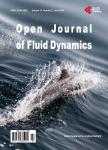A Micromixer Using the Taylor-Dean Flow: Effect of Inflow Conditions on the Mixing
A Micromixer Using the Taylor-Dean Flow: Effect of Inflow Conditions on the Mixing作者机构:Technical Division Tsurumi Manufacturing Co. Ltd. Tottori Japan Department of Mechanical Engineering Yonago National College of Technology Tottori Japan Graduate School of Natural Science and Technology Okayama University Okayama Japan
出 版 物:《Open Journal of Fluid Dynamics》 (流体动力学(英文))
年 卷 期:2014年第4卷第5期
页 面:463-471页
学科分类:07[理学] 0701[理学-数学] 070101[理学-基础数学]
主 题:Taylor-Dean Flow Chaotic Mixing Secondary Flow LIF CFD
摘 要:Chaotic mixing in a curved-square channel flow is studied experimentally and numerically. Two walls of the channel (inner and top walls) rotate around the center of curvature and a pressure gradient is imposed in the direction toward the exit of the channel. This flow is a kind of Taylor-Dean flows. There are two parameters dominating the flow, the Dean number De (∝ the pressure gradient or the Reynolds number) and the Taylor number Tr (∝ the angular velocity of the wall rotation). In the present paper, we analyze the physical mechanism of chaotic mixing in the Taylor-Dean flow by comparing experimental and numerical results. We produced a micromixer model of the curved channel several centimeters long with square cross section of a few millimeters side. The secondary flow was measured using laser induced fluorescence (LIF) method to examine secondary flow characteristics. We also performed three-dimensional numerical simulations for the exactly same configuration as the experimental system to study the mechanism of chaotic mixing. It is found that good mixing performance is achieved for the case of De ≤ 0.1Tr, and that mixing efficiency changes according to the difference in inflow conditions. The flow is studied both experimentally and numerically, and both results agree with each other very well.



